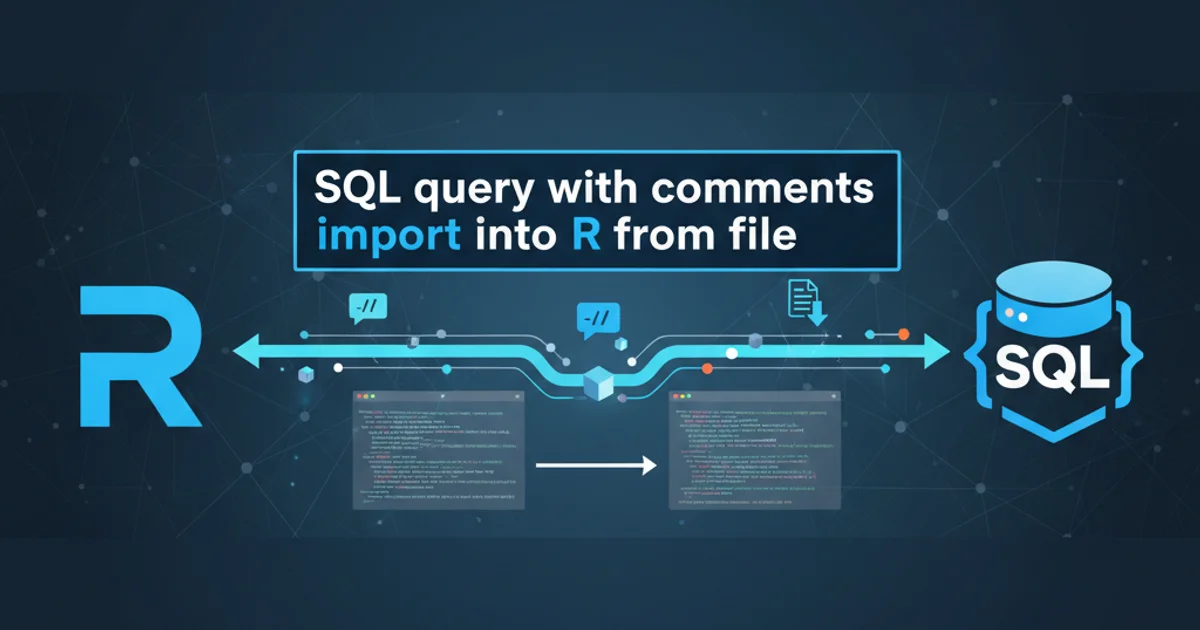SQL query with comments import into R from file
Importing SQL Queries with Comments into R from a File

Learn how to effectively import and execute SQL queries containing comments from an external file into R, ensuring proper parsing and execution for robust data analysis workflows.
When working with R for data analysis, it's common to interact with databases using SQL queries. For complex or frequently used queries, storing them in external .sql files is a best practice. This approach promotes reusability, version control, and readability. However, a common challenge arises when these SQL files contain comments, as standard R functions might misinterpret them, leading to execution errors. This article will guide you through robust methods to import and execute SQL queries with comments from a file into R.
The Challenge: SQL Comments and R's Interpretation
SQL queries often include comments for documentation, debugging, or temporarily disabling parts of the query. These comments can be single-line (-- comment) or multi-line (/* comment */). When you read an .sql file directly into R using functions like readLines(), the entire content, including comments, is treated as part of the query string. Database drivers or R's SQL execution functions might then struggle to parse this combined string, especially if comments are not correctly handled or if they interfere with the query's structure.
flowchart TD
A[SQL File with Comments] --> B{Read into R}
B --> C{Raw String in R}
C --> D{Database Driver}
D -- X Error --> E[Query Execution Failed]
D -- ✓ Success --> F[Query Executed]Flowchart illustrating the challenge of importing SQL with comments into R.
Method 1: Basic File Reading and String Manipulation
The most straightforward approach involves reading the file content and then using R's string manipulation functions to remove comments before execution. This method offers fine-grained control but requires careful handling of different comment types.
-- This is a single-line comment
SELECT
column1, -- Inline comment
column2
FROM
your_table
WHERE
column3 = 'value';
/*
This is a multi-line comment.
It can span several lines.
*/
SELECT * FROM another_table;
read_sql_query <- function(file_path) {
sql_content <- readLines(file_path, warn = FALSE)
# Remove single-line comments (-- comment to end of line)
sql_content <- gsub("--.*", "", sql_content)
# Remove multi-line comments (/* comment */)
# This is more complex as it can span lines.
# A common approach is to collapse and then use regex.
sql_collapsed <- paste(sql_content, collapse = "\n")
sql_collapsed <- gsub("/\\*.*?\\*/", "", sql_collapsed, perl = TRUE)
# Remove empty lines and trim whitespace
sql_collapsed <- gsub("^\\s*|\\s*$", "", sql_collapsed)
sql_collapsed <- gsub("\n+", "\n", sql_collapsed) # Collapse multiple newlines
return(sql_collapsed)
}
# Example usage:
# query <- read_sql_query("path/to/your/query.sql")
# print(query)
# dbGetQuery(con, query) # Assuming 'con' is your database connection
perl = TRUE argument in gsub() is crucial for multi-line regex patterns, especially when dealing with the non-greedy .*? quantifier to correctly match multi-line comments without over-matching.Method 2: Using the sqlr Package
For a more robust and less error-prone solution, especially when dealing with complex SQL files, dedicated R packages can be invaluable. The sqlr package (or similar alternatives) provides functions specifically designed to parse SQL files, often handling comments and query separation automatically. While sqlr might not be directly available on CRAN, the concept of using a specialized package is powerful.
# Install if not already installed (example for a hypothetical package)
# install.packages("sqlr")
library(DBI)
library(RSQLite)
# Assuming 'sqlr' package has a function like read_sql_file
# This is a conceptual example, as 'sqlr' is not a standard CRAN package.
# If you have a custom package or a similar utility, this demonstrates its use.
# Example of a hypothetical function from a package:
# read_sql_file <- function(file_path) {
# # Internal logic to parse SQL, remove comments, and split queries
# # Returns a list of cleaned SQL queries
# }
# For demonstration, let's simulate a cleaned query
cleaned_query <- "SELECT column1, column2 FROM your_table WHERE column3 = 'value';"
# Establish a dummy database connection for demonstration
con <- dbConnect(RSQLite::SQLite(), ":memory:")
# Execute the cleaned query
# dbGetQuery(con, cleaned_query)
# Don't forget to disconnect
dbDisconnect(con)
sqlr is used as a conceptual example here, you might find similar functionality in packages like dbplyr for building SQL queries programmatically, or custom utility functions within your organization that handle SQL file parsing. The key takeaway is to leverage tools that abstract away the complexity of comment removal.Best Practices for SQL Files and R Integration
Regardless of the method chosen, adhering to certain best practices can significantly improve your workflow when integrating SQL queries from files into R:
1. Standardize Comment Styles
If you're manually cleaning queries, agree on a consistent comment style (e.g., always /* ... */ for blocks, -- for lines) to simplify regex patterns.
2. Test Query Cleaning
Always test your comment removal logic with various SQL files, including edge cases like comments within strings or complex multi-line comments.
3. Separate Queries
If your .sql file contains multiple queries, ensure your parsing logic can correctly identify and separate them (e.g., by semicolons), so you can execute them individually if needed.
4. Use Parameterized Queries
Avoid concatenating R variables directly into SQL strings. Instead, use parameterized queries (e.g., dbSendQuery(con, 'SELECT * FROM table WHERE id = ?', params = list(my_id))) to prevent SQL injection vulnerabilities and improve readability.
5. Error Handling
Implement robust error handling around your database calls to catch issues during query execution and provide informative feedback.